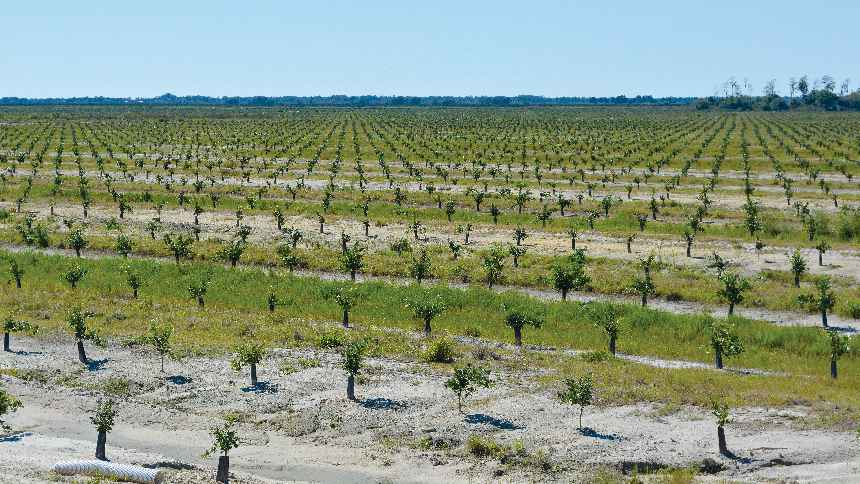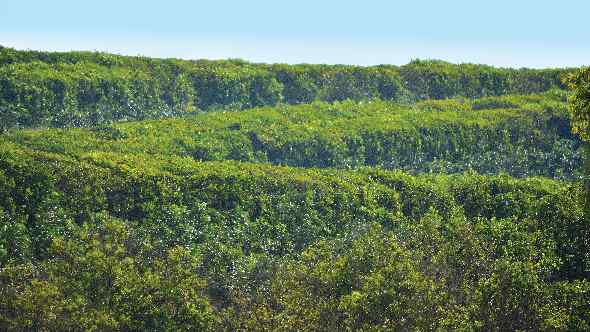Positive Attitudes Promote Citrus Planting

Photo by Frank Giles
After two seasons of serious fruit drop, many Florida citrus growers wonder if drastically falling production numbers are a bump in the road or the beginning of a disturbing trend. Despite the challenges, some growers believe they can produce profitable yields even in the presence of HLB.
A panel discussion during Citrus Expo in August featured the positive attitudes of three growers who are replanting with a firm belief they can bring trees into production. Jim Snively, Southern Gardens Citrus; Rob Atchley, A. Duda and Sons; and Andy Tuck, Crews Grove discussed their replanting efforts and detailed what seems to be working or not to keep HLB at bay. All agreed intensive management is the only hope for success in the future.
Snively opened the discussion by challenging the notion that only the largest growers like Southern Gardens have the resources to manage citrus at such a high level.
“I am going to tell you what Southern Gardens is doing, but I’m also a small grower,” he said. “You hear a lot of people say, ‘Only the big growers can do all these things.’ I am doing all of these things in my small grove as well.”
He noted just how far research has come since HLB was found in Florida in 2005.
“The philosophy at Southern Gardens is to keep everything moving because we want to be here and in a good position when things turn around,” he said. “The research will get there, so just hang on until it does.”
“We have put in about 419,000 resets in existing groves since greening,” Snively said. “We estimate those resets planted from 2008 to today are about 4% infected. We feel that is success.”
Snively conceded some mistakes were made in planting a new 40-acre block in 2010. Early inspections of the grove showed a 6% infection rate. The next month it was 8% and today it is 46% infected with greening.
“The trees were treated with imidacloprid at the nursery, so we felt like we had a little time after we planted them,” he said. “We started our psyllid spray program about two or three weeks after planting and applied imidacloprid four weeks after they were in the ground.”
After consulting with researchers, Snively learned they waited too long to start the imidacloprid application. When a tree goes into the ground, it needs imidacloprid within a day or two.
Southern Gardens applied this knowledge to a new 60-acre planting that is now two years old. Imidacloprid was being applied as the trees were being planted. That, combined with an aggressive psyllid control program with other products, has helped to keep the greening infection rate at 0.6%.
“What are we doing going forward?” Snively asked. “We are planting 300 acres now because we believe we can keep HLB at low levels and get these trees in production. We have put in our budget for another 500 acres to be planted in the coming year and plan to plant another 400,000 resets over the next couple of years. We are moving forward.”
The new plantings are at higher densities. They are looking at varying densities to speed trees into production. The farm has invested in a small tractor to operate in the smaller spaces between rows — a John Deere 5093EN. “When it comes to nutritionals, all I am going to tell you is you need them,” Snively said. “You need to keep your trees healthy.”
Canopy Maintenance
Tuck pointed out a major observation made in their groves on the Ridge is the importance of keeping the canopy in sync with the root system.
“We believe canopy maintenance is absolutely key to managing greening,” he said. “We’ve been told the bacteria goes directly to the roots once a tree is infected and that you lose 30% to 40% of the root system before you see symptoms above ground. I was observing trees looking really bad, and after we picked them, they started looking good. Two months later, they had a good flush and bloom growing.”

Citrus grower Andy Tuck says canopy maintenance is critical in keeping roots in sync with the tree above. Photo by Frank Giles
“Our company had never been fond of hedging and topping trees,” Tuck said. “But, we started to notice a couple of our customer groves that were on a good maintenance program and some of our groves where we have to do it looked relatively untouched by the disease.”
This led Tuck to put two and two together and realize the importance of keeping trees cut back to a manageable level, so the root system can support the growth above. New plantings are going in at higher densities as well to bring production up per acre.
“We are confident we can manage this disease and maintain profitability with new plantings going in,” he said. “I am as hopeful for this industry as I’ve ever been.”
Feeding Tops And Bottoms
Atchley discussed the 2,900-acre expansion under way at Duda’s LaBelle property. The company also is returning to a normal yearly reset program to replace declining trees in mature groves.
“The short and sweet answer is we are planting because we believe in the viability of citrus and believe there’s money to be made and careers to be completed in this business,” he said.
Among the top items on Atchley’s agenda is enhancing the nutrition of the trees through foliar applications and taking care of roots.
“When greening came to the forefront, there was so much talk about foliar nutrition, but we sort of forgot about the roots,” he said. “We are not neglecting our roots and have ramped up our foliar nutrition program. We have shifted to more nitrates and more soluble materials easier for the trees to absorb.
“And, we are feeding the trees in smaller, easier to chew pieces. We are feeding more often. Last year, from February until October, the trees were getting spoon fed through the leaves.”
In addition, Atchley is a big believer in controlled-release fertilizer, which is put in the hole when a new tree is planted. “The controlled-release material has worked very well for us,” he said. “It seems to smooth out the availability of nutrition. I especially like it during the rainy season because it keeps fertilizer available to the roots.”










